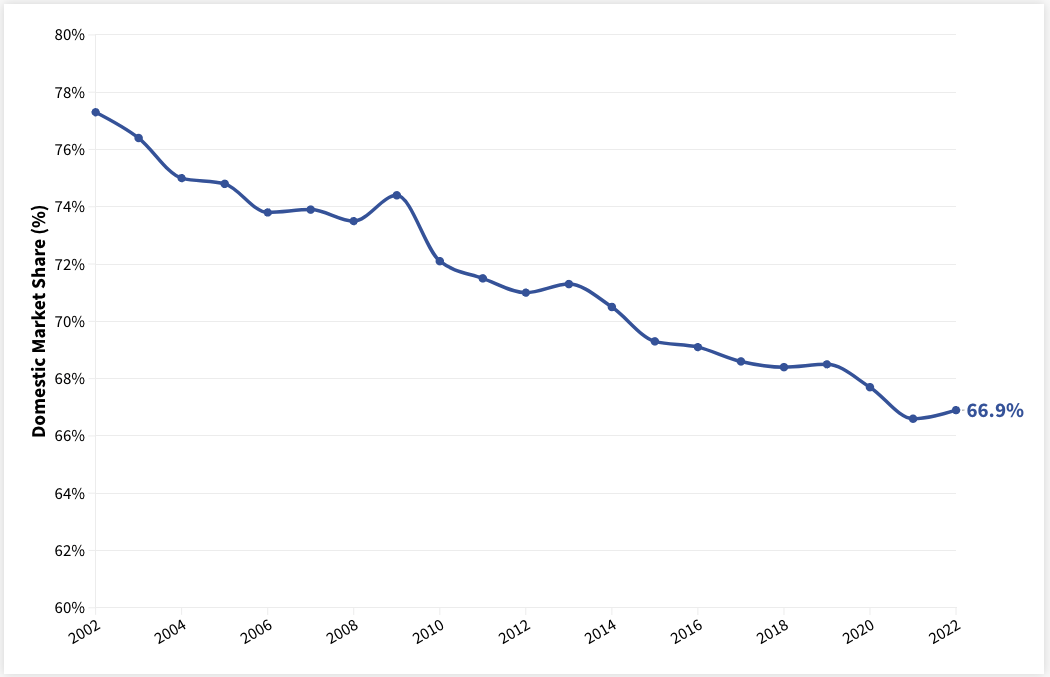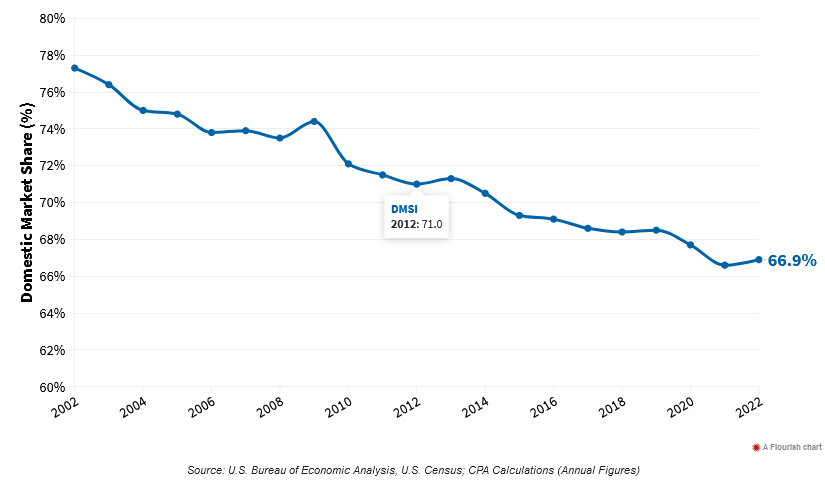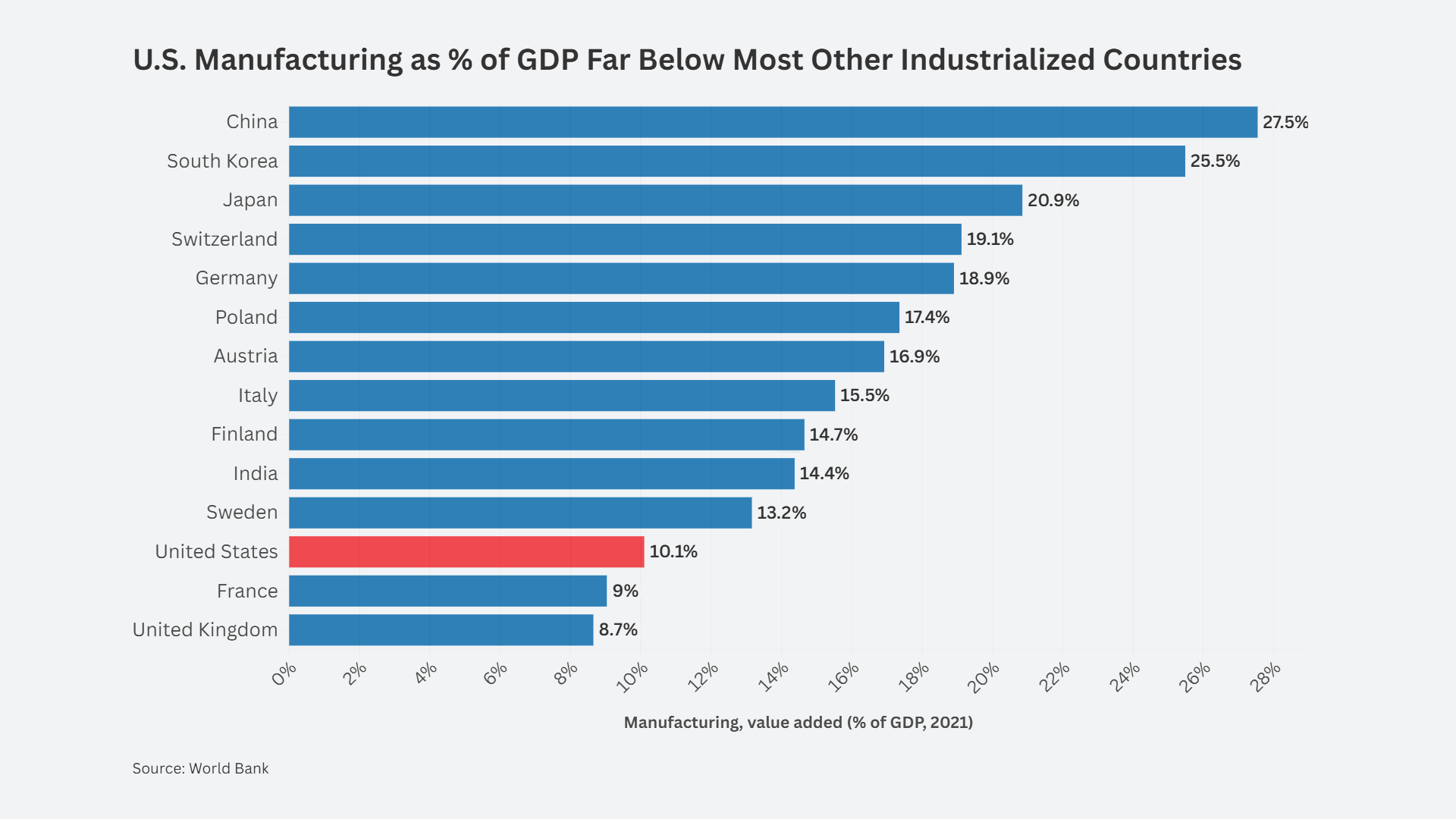WASHINGTON — The Coalition for a Prosperous America (CPA) today released a quarterly update to the Domestic Market Share Index (DMSI) which measures the market share of U.S. manufacturing producers in the U.S. home market. The DMSI increased slightly to 67.8 in the fourth quarter 2022, up 1.3 percentage points from the third quarter, reflecting a slowdown in imports at the end of the year. For the entire year, the index was 66.9 in 2022, an increase of 0.3 percentage points from the previous year. After imports surged in 2021 and the first three quarters of 2022, imports stabilized in the fourth quarter.
While policy makers often talk of access to foreign markets, the biggest market in the world is the U.S. consumer market where producers have lost market share in the last decades. The U.S. trade deficit in manufactured goods rose 13% to $1.199 trillion last year, an all-time record. The manufacturing trade deficit grew at a faster rate than the overall goods trade deficit in 2022, which increased by 9%.
“U.S. manufacturers continue to lose share in the U.S. market, and our trade deficit in manufactured goods set a new record in 2022,” said CPA chief economist Jeff Ferry. “Rebuilding domestic production is the only way to create good jobs, boost economic growth, and address growing inequality in America.”
Figure 1: Domestic Market Share Index (DMSI) (2002-2022)

The DMSI measures the share that U.S. domestic producers hold of the U.S. market for manufactured goods. A DMSI of 66.9 means that foreign producers hold about one third of the U.S. market for manufactured goods in the form of imports. The U.S. market for manufactured goods, worth about $7.2 trillion, is the world’s largest market. Since 2002, U.S. manufacturers have lost more than ten percentage points of home market share, falling from 77.3% in 2002 to 66.9% for 2022. This represents a huge setback for U.S. producers, who have traditionally been strongest in the home market.
In Q4, gains were strongest among producers of primary metals and textiles, each gaining 4.4 percentage points of the domestic market. Producers of apparel also regained market share, increasing from 7.7% to 11.6%. Yet, all three of these industries remain below the average DMSI for the overall manufacturing industry. The apparel sector remains the sector in which domestic manufacturers hold the smallest percentage of the domestic market. Among sectors that lost the most market share over the quarter, U.S. motor vehicles manufacturers lost 1.1 percentage points of the domestic market falling to a 67.1% share of the domestic market.
By import source, the European Union gained 0.8 percentage points of the U.S. domestic market in 2022, increasing from 6.7% to 7.5%. Overtaking China, the 27-nation EU became the largest source of manufactured goods to the U.S. in the fourth quarter. Gains of market share by EU countries were most pronounced in Ireland and Germany. The two nations gained market share in chemical products by 2.1 percentage points combined. Motor vehicle imports from Germany also gained 0.6 percentage points.
China’s share of the market for manufactured goods in the U.S. fell by half a percentage point in 2022 to its lowest level since 2012. Since the implementation of Section 301 tariffs in 2018, China’s share of the U.S. domestic manufactured goods market has fallen from a record high of 8.1% to 6.8% in 2022. Textiles and computer & electronic products were the largest drivers of the decline, losing 2.4 and 2.1 percentage points of market share, respectively. For the year, China lost market share in 12 of the 19 subsectors. While China continues to hold the largest share of the U.S. market by a single foreign country, policies aimed at decoupling the two economies have had an impact to decrease China’s share of the U.S. market.
Canada and Mexico’s combined share of the U.S. domestic market rose only 0.1 percentage point in 2022 despite the buzz about friendshoring. In 2022, the USMCA partners had a combined share of 9.1%. Mexico is the second largest source of manufactured goods in the U.S. with a 5.5% share and Canada is third with 3.6%.













